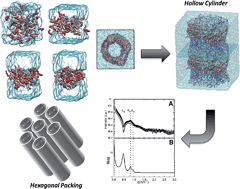How does growth hormone releasing hexapeptide self-assemble in nanotubes?
Abstract
Growth hormone releasing peptide, GHRP-6, a hexapeptide (His-(D-Trp)-Ala-Trp-(D-Phe)-Lys-NH2, MW = 872.44 Da) that belongs to a class of synthetic growth hormone secretagogues, can stimulate growth hormone secretion from somatotrophs in several species including humans. In the present study, we demonstrate that GHRP-6 dispersed in aqueous solution, at pH 7.0, room temperature of 22 °C, is able to form long nanotubes, which is evidenced by combining small angle X-ray scattering (SAXS), transmission electron microscopy and molecular dynamics simulation results. Such nanotubes possess inner and outer cross-sections equal to 6.7(2) nm and 13.4(5) nm, respectively. The mechanism of peptide self-assembly was determined by molecular dynamics simulations revealing that the peptides self-assemble like amphiphilic molecules in aqueous solution in a partially interdigitated structure. In this case, the position of the positively charged amino terminus is located at the peptide–water interface, whereas the neutral NH2-capped carboxy terminus remains buried at the hydrophobic core. In contrast, the long side chain of Lys-6 stretches out of the hydrophobic core positioning its positive charge near the cylinder surface. The peptide configuration in the nanotube wall comes from the interplay between the hydrophobic interactions of the aromatic side chains of GHRP-6 and the electrostatic repulsion of its cationic charges. On increasing the peptide concentration, the long nanotubes self-arrange in solution displaying a bi-dimensional hexagonal-like packing in the SAXS curves, with a center-to-center distance of ∼15 nm. Further, we also show that the nanostructure formed in solution is quite stable and is preserved following transfer to a solid support.


 Please wait while we load your content...
Please wait while we load your content...